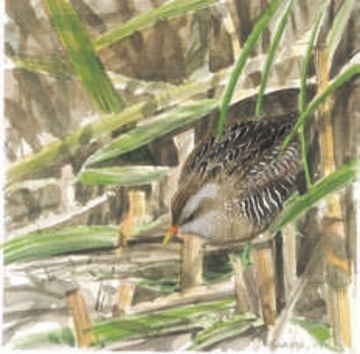Spotted Crake (Porzana porzana)

Spotted Crake © Ray Scally
There was just one record of this rare migrant in our Atlas period, when the bird’s whiplash call was heard in juncus at Inner Marsh Farm (SJ37B) for one night only, 11 May 2005. Spotted Crakes return from their wintering areas in Southern Europe and Africa in April or May, and some birds sing through to early-July. As detailed in our First Atlas, one or two Spotted Crakes nested in the county during the 1930s and single birds were recorded as possibly breeding seven times in the years from then to 1984. The annual county bird reports then list single birds in the breeding season in 1985, 1992, 1995, 2002 and 2003, suggesting more frequent occurrence.
The first Britain-wide survey in 1999 found 73 singing males, including one in Cheshire, not included in the annual bird report (Gilbert et al 2002). In every other year the species is under-recorded, and under-reported to the Rare Breeding Birds Panel, who comment ‘Around 10-30 pairs of Spotted Crakes probably nest annually in suitable wetlands, although most breeding season records are simply of singing birds, with very few instances of confirmed breeding’ (Holling et al 2007). The RBBP’s listing of a bird in Cheshire and Wirral in 2004 is thought to be a mistake for the 2005 bird noted above.
The national survey showed that they favour wet herb habitats, with Phragmites and wet grass as less-preferred sites; they need tall vegetation and shallow standing water that persists through the breeding season, with a mosaic feeding area of tussocks of wet sedge Carex or grass species and drier areas. There potentially is habitat meeting this description at several sites in the county.

